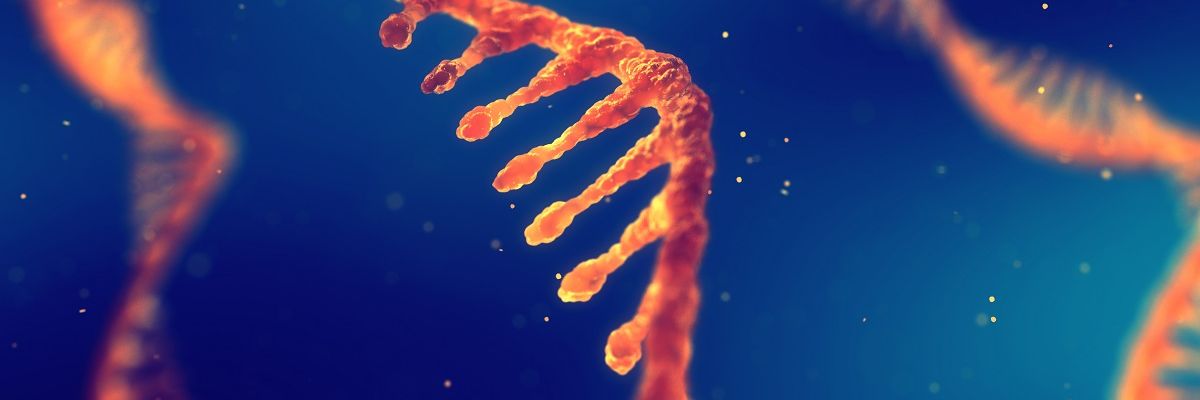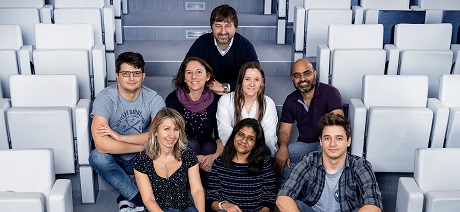
CAS researchers describe how cells assemble the molecular scissors that cut RNA
28. 11. 2023
With a bit of imagination, we can picture the Gemin3 protein as a sort of molecular hairdresser. The protein, discovered almost 25 years ago, was known to be essential, as no organism can survive without it. However, it was not entirely clear what it was actually for – until now. Research teams from the Institute of Molecular Genetics of the CAS and the Institute of Microbiology of the CAS have succeeded in showing that the protein plays an important role in a process called RNA splicing. The research results were published in Nature Communications.
The structural transformation of RNA molecules in a form that resembles a clenched fist unclenching, but on the scale of nanometres, is what activates one of the fundamental molecular processes of life. “The existence of so-called spliceosomal small nuclear RNA molecules has been known for decades. What we found out is that snRNAs, whose genes are located on the DNA double helix in every single cell of the human body, can also occur in a state previously unknown to us and that in order for the process of RNA splicing to begin, this state must change,” explains Josef Pánek from the Institute of Microbiology of the CAS.
This structural rearrangement is caused by an interaction with another molecule that is also present in all human cells and whose function has also been unclear until now. “Figuratively speaking, the interaction can be likened to tickling one set of molecules with another in the exact right place,” Pánek notes.
How to read the book of genes
Human DNA contains approximately 20,000 genes, which we can imagine as the “pages” of our “gene book”. Each page contains instructions for making a particular protein. Prior to the protein being made, the information from the DNA is transcribed into an RNA molecule called pre-mRNA, which is an exact copy of that ‘page’ in the DNA.
Only a small portion (about one-tenth) contains the information to make a given protein, while the rest is removed in a process called RNA splicing. This is done by the spliceosome, a large ribonucleoprotein complex or molecular scissors (the “splicing complex”) which consist of 150 protein components that must fit together precisely for the scissors to work properly.
The RNA hairdresser
An international research team led by David Staněk at the Institute of Molecular Genetics of the CAS, in collaboration with the Institute of Microbiology of the CAS, the Julius Maxmilian University of Wurburg, and Yale University, found that some of the ‘pieces’ must first be modified in order to fit correctly into the puzzle, and identified and described the protein that is responsible for these modifications. The protein is part of a larger complex whose malfunctions cause motor neuron death and muscular dystrophy.

David Staněk’s team at the Institute of Molecular Genetics of the CAS.
“The protein, called Gemin3, was discovered nearly twenty-five years ago. It was known to do something very important in the body because no organism could survive its removal, but it was not known what exactly that was,” Staněk explains. Using mathematical modelling, the research team discovered that the small RNAs, which are part of the splicing complex, do not look as they are depicted in molecular biology textbooks and cannot function properly in this form.
“We were able to confirm the mathematical predictions of our colleagues from the Institute of Microbiology experimentally and show that Gemin3 acts as a kind of hairdresser that combs the small RNAs to fit into the splicing complex,” Staněk adds.
The research results facilitate our understanding of the basic mechanisms of how human cells function. David Staněk and his team are making use of them, for instance, in the study of inherited diseases affecting the retina.
Prepared by: Leona Matušková, External Relations Division, CAO of the CAS, drawing on the press release of the CAS (in Czech)
Translated by: Tereza Novická, External Relations Division, CAO of the CAS
Photo: Shutterstock; Institute of Molecular Genetics of the CAS
 The text is released for use under the Creative Commons licence.
The text is released for use under the Creative Commons licence.
Read also
- SUNER-C concludes after three years dedicated to the renewable energy future
- A trapped state: The pandemic impact on public attitudes, trust, and behavior
- Aerial archaeology: Tracing the footsteps of our ancestors from the sky
- Archaeologists uncover ancient finds along Prague Ring Road
- Our microbiome largely depends on what we eat, says microbiologist Michal Kraus
- The ABCs of writing: Why did its invention mark a turning point for humankind?
- We learn, remember, forget… What can memory actually do? And can we outsmart it?
- New Center for Electron Microscopy in Brno opens its doors to global science
- The hidden lives of waste: What can we learn from waste workers and pickers?
- A unique lab is hidden right beneath Prague’s Vítkov Hill
The Czech Academy of Sciences (the CAS)
The mission of the CAS
The primary mission of the CAS is to conduct research in a broad spectrum of natural, technical and social sciences as well as humanities. This research aims to advance progress of scientific knowledge at the international level, considering, however, the specific needs of the Czech society and the national culture.
President of the CAS
Prof. Eva Zažímalová has started her second term of office in May 2021. She is a respected scientist, and a Professor of Plant Anatomy and Physiology.
She is also a part of GCSA of the EU.